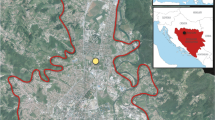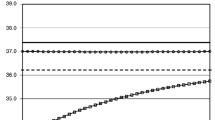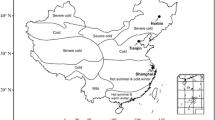Abstract
Leisure walking is affected by meteorological conditions. However, it is still not clear what scales of meteorological conditions and thermal status affect the number of people who choose to leisure walk. Using a time series regression, this study examines the heat—leisure walking relationship by analyzing the effect of the seasons, weather, microclimate, and outdoor thermal comfort on walking count. Eight thermal indexes were selected to estimate the pedestrians’ thermal comfort, and their predictive capacities in walking count were evaluated. Particular consideration was given to identifying heat thresholds of walking that determined the tolerance range of pedestrian heat stress. Four years of hourly daytime walking counts and publicly available ASOS meteorological data at Seoul-lo 7017, a pedestrian bridge in Seoul, were used for the analysis. Our findings indicate that walking count is correlated with seasonal climatic variations, with the highest number of pedestrians observed in fall and the lowest in summer. Moreover, air temperature played a vital role, showing that a 5.0 °C rise in temperature was associated with a 1.34% rise in the square root of the walking count. Its impact becomes greater when combined with intense solar radiation and higher absolute humidity. The heat threshold for walking was between 23.8 °C and 26.2 °C. Empirical model indexes showed the highest predictive capacity in walking count at approximately 30.0%, which was followed by rational model indexes at 28.0%.




Similar content being viewed by others
References
ANSI/ASHRAE Standard 55 (2017) Thermal Environmental Conditions for Human Occupancy
Attaset V, Schneider RJ, Arnold LS, Ragland DR (2010) Effects of Weather Variables on Pedestrian Volumes in Alameda County, California. TRB 2010 Annual Meeting Research report. http://escholarship.org/uc/item/3zn9f4cr
Aultman-Hall L, Lane D, Lambert RR (2009) Assessing Impact of Weather and Season on Pedestrian Traffic Volumes. Transp Res Rec. https://doi.org/10.3141/2140-04
Auliciems A, Szokolay SV (2007) Thermal Comfort, 2nd edn. The University of Queensland, Brisbane
Binarti F, Koerniawan MD, Triyadi S, Utami SS, Matzarakis A (2020) A review of outdoor thermal comfort indices and neutral ranges for hot-humid regions. Urban Climate 31
Błażejczyk K (2006) MENEX_2005 - the Revised Version of Man-Environment Heat Exchange Mode. www.igipz.pan.pl/geoekoklimat/blaz/menex.htm
Błażejczyk K, Jendritzky G, Bröde P, Fiala D, Havenith G, Epstein Y, Psikuta A, Kampmann B (2013) An introduction to the Universal Thermal Climate Index (UTCI). Institute of Geography and Spatial Organization Polish Academy of Sciences
Blazejczyk K, Matzarakis A (2007) Assessment of bioclimatic differentiation of Poland based on the human heat balance. Geogr Pol 80:63–82
Böcker L, Dijst M, Prillwitz J (2013) Impact of everyday weather on individual daily travel behaviours in perspective a literature review. Transp Rev 33(1):71–91
Brager GS, de Dear RJ (1998) Thermal adaptation in the built environment a literature review. Energy Build
Brodersen NH, Steptoe A, Williamson S, Wardle J (2005) Sociodemographic, developmental, environmental, and psychological correlates of physical activity and sedentary behavior at age 11 to 12. Ann Behav Med 29:2–11
Brown RD, Gillespie TJ (1986) Estimating outdoor thermal comfort using a cylindrical radiation thermometer and an energy budget model. Int J Biometeorol 30:43–52. https://doi.org/10.1007/BF02192058
Carron AV, Hausenblas HA, Estabrooks PA (2003) The psychology of physical activity. McGraw Hill
Centers for Disease Control and Prevention (2010) National Health and Nutrition Examination Survey Data. https://www.cdc.gov/nchs/nhanes/index.htm
Chan CB, Ryan DA (2009) Assessing the effects of weather conditions on physical activity participation using objective measures. Int J Environ Res Public Health 6(10):2639–2654. https://doi.org/10.3390/ijerph6102639
Chen L, Ng E (2012) Outdoor thermal comfort and outdoor activities: a review of research in the past decade. Cities 29:118–125
Cheng H, Garrick DJ, Fernando RL (2017) Efficient strategies for leave-one-out cross validation for genomic best linear unbiased prediction. J Anim Sci Biotechnol 8:38
Climate Central (2019) Extreme Heat: When Outdoor Sports Become Risky
Coccolo S, Kämpf J, Scartezzini JL, Pearlmutter D (2016) Outdoor human comfort and thermal stress: a comprehensive review on models and standards. Urban Clim 18:33–57. https://doi.org/10.1016/j.uclim.2016.08.004
Cochrane D, Orcutt GH (1949) Application of least squares regression to relationships containing auto-correlated error terms. J Am Stat Assoc 44(245):32–61. https://doi.org/10.1080/01621459.1949.10483290
Cools M, Moons E, Creemers L, Wets G (2010) Changes in travel behavior in response to weather conditions: do type of weather and trip purpose matter? Transp Res Rec J Transp Res Board 2157:22–28
Copperman RB, Bhat CR (2007) An analysis of the determinants of children’s weekend physical activity participation. Transportation 34:67–87
De Freitas CR (2003) Tourism climatology: evaluating environmental information for decision making and business planning in the recreation and tourism sector. Int J Biometeorol 48:45–54
De Freitas CR, Grigorieva E (2015) A comprehensive catalogue and classification of human thermal climate indices. Int J Biometeorol 59:1–12
De Freitas CR, Grigorieva E (2017) A comparison and appraisal of a comprehensive range of human thermal climate indices. Int J Biometeorol 61:1–26
De Freitas CR, Scott D, McBoyle G (2007) A second generation climate index for tourism (CIT): specification and verification. Int J Biometeorol 52(5):399–407
Dufour JM, Gaudry MJI, Liem TC (1980) The Cochrane-Orcutt procedure numerical examples of multiple admissible minima. Econ Lett 6(1):43–48
Efron B (1982) The Jackknife, the Bootstrap and other resampling plans. In CBMS-NSF regional conference series in applied mathematics. Society for Industrial and Applied Mathematics (SIAM), Philadelphia
Erell E, Pearlmutter D, Williamson T (2010) Urban microclimate: designing the spaces. Earthscan/James & James Science Publishers, London
Fanger PO (1970) Thermal comfort. McGraw Hill, New York
Fanger PO (1972) Thermal comfort: analysis and applications in environmental engineering. McGraw-Hill, New York
Fragoso TM, Bertoli W, Louzada F (2018) Bayesian model averaging: a systematic review and conceptual classification. Int Stat Rev 86:1–28. https://doi.org/10.1111/insr.12243
Gagge AP, Fobelets AP, Berglund LG (1986) A standard predictive index of human response of the thermal environment. ASHRAE Trans 92:709–731
Givoni B (1969) Man, climate and architecture. Elsevier, Amsterdam
Havenith G, Fiala D (2015) Thermal indices and thermophysiological modeling for heat stress. Compr Physiol 6(1):255–302. https://doi.org/10.1002/cphy.c140051
Health, United States (2005) with chartbook on trends in the health of Americans. US Department of Health and Human Services, Centers for Disease Control and Prevention, National Center for Health Statistics
Henri T (1971) Best linear unbiased estimation and prediction. Principles of Econometrics. Wiley, New York, pp 119–124 (ISBN 0-471-85845-5)
Hinne M, Gronau QF, Dvd B, Wagenmakers E-J (2020) A conceptual introduction to Bayesian model averaging. Adv Methods Pract Psychol Sci 3(2):200–215
Hoeting JA, MadiganD RAE, Volinsky CT (1999) Bayesian model averaging: A tutorial with discussion. Stat Sci 14:382–417
Höppe P (2002) Different aspects of assessing indoor and outdoor thermal comfort. Energy Build 34:661–665
Jendritzky G, Nübler W (1981) A model analysing the urban thermal environment in physiologically significant terms. Arch Met Geoph Biokl Ser B 29:313–326
Jendritzky G, de Dear R (2009) Adaptation and thermal environment. In: Ebi KL, Burton I, McGregor GR (eds) Biometeorology for adaptation to climate variability and change. Biometeorology 1:9–32
Jendritzky G, de Dear R, Havenith G (2012) UTCI–why another thermal index? Int J Biometeorol 56(3):421–428. https://doi.org/10.1007/s00484-011-0513-7
Johansson E, Thorsson S, Emmanuel R, Krüger E (2014) Instruments and methods in outdoor thermal comfort studies - The need for standardization. Urban Clim 10:346–366
Katić K, Li R, Zeiler W (2016) Thermophysiological models and their applications: a review. Build Environ 106:286–300
Kerslake DM (1972) The stress of hot environment. Cambridge University Press, Cambridge
Kim YJ, Brown RD (2021) A multilevel approach for assessing the effects of microclimatic urban design on pedestrian thermal comfort: The High Line in New York. Build Environ 205
Lemke B, Kjellstrom T (2012) Calculating workplace WBGT from meteorological data: a tool for climate change assessment. Ind Health 50(4):267–278. https://doi.org/10.2486/indhealth.ms1352 (Epub 2012)
Lin T-P (2009) Thermal perception, adaptation and attendance in a public square in hot and humid regions. Build Environ
Lin T-P, Tsai K-T, Liao C-C, Huang Y-C (2013) Effects of thermal comfort and adaptation on park attendance regarding different shading levels and activity types. Build Environ 59:599–611
Liu C (2016) Understanding the Impacts of Weather and Climate Change on Travel Behaviour. [Doctoral Dissertation, KTH Royal Institute of Technology in Stockholm]. DiVA
Liu S, Nazarian N, Niu J, Hart M, De-Dear R (2020) From thermal sensation to thermal affect: a multi-dimensional semantic space to assess outdoor thermal comfort. Build Environ 182:107112
Manwell JF, McGowan JG, Rogers AL (2002) Wind energy explained, 1st edn. John Wiley & Sons Ltd, Chichester
Margery GD (1993) Exploring your world: the adventure of geography. National Geographic Society, Washington, D.C.
Miranda-Moreno LF, Fernandes D (2011) Modeling of pedestrian activity at signalized intersections: land use, urban form, weather, and spatiotemporal patterns. Transp Res Rec J Transp Res Board 2264(1):74–82
Miranda-Moreno LF, Lahti AC (2013) Temporal trends and the effect of weather on pedestrian volumes: A case study of Montreal, Canada. Transp Res D Transp Environ 22:54–59
Montigny Ld, Ling R, Zacharias J (2012) The effects of weather on walking rates in nine cities. Environ Behav 44(6):821–840. https://doi.org/10.1177/0013916511409033
Na D, Pan J, Lee J (2017) A Study on the Use of Seoullo 7017 and its Effect, The Seoul Institute, Seoul. http://global.si.re.kr/content/study-use-seoullo-7017-and-its-effect
Nicol F, Humphreys M (1973) Thermal comfort as part of a self-regulating system. Build Res Pract 1:174–179
Nikolopoulou M, Steemers K (2003) Thermal comfort and psychological adaptation as a guide for designing urban spaces. Energy Build 35:95–101
Office of the Surgeon General (2015) Publications and Reports of the Surgeon General. Step It Up! The Surgeon General's Call to Action to Promote Walking and Walkable Communities. Washington (DC), US Department of Health and Human Services
Park S, Tuller SE (2011) Human body area factors for radiation exchange analysis: standing and walking postures. Int J Biometeorol 55:695–709
Parsons K (2014) Human Thermal Environments: The Effects of Hot, Moderate, and Cold Environments on Human Health, Comfort, and Performance, 3rd edn. CRC Press Inc, USA
Prins RG, Lenthe FJ (2015) The hour-to-hour influence of weather conditions on walking and cycling among Dutch older adults. Age Ageing 44(5):886–890
Potchter O, Cohen P, Lin T, Matzarakis A (2018) Outdoor human thermal perception in various climates: A comprehensive review of approaches, methods and quantification. Sci Total Environ 631–632:390–406
Shaaban K, Muley D (2016) Investigation of weather impacts on pedestrian volumes. Transp Res Procedia 14:115–122
Shakir AK (2001) Thermal Comfort Modelling of an Open Space (Sport Stadium). Unpublished Thesis. University of Strathclyde, Glasgow, UK
Sharifi E, Boland J (2018) Limits of thermal adaptation in cities outdoor heat activity dynamics in Sydney Melbourne and Adelaide. Architect Sci Rev 61(4). https://doi.org/10.1080/00038628.2018.1482824
Sharifi E, Sivam A, Boland J (2016) Resilience to heat in public space: a case study of Adelaide. South Australia. J Environ Plan Manag 59(10). https://doi.org/10.1080/09640568.2015.1091294
Siple PA, Passel CF (1945) Measurements of dry atmospheric cooling in sub-freezing temperatures. Proc Am Philos Soc 89:177–199
Staiger H, Laschewski G, Matzarakis A (2019) Selection of appropriate thermal indices for applications in human biometeorological studies. Atmosphere 10:18
Tucker P, Gilliland J (2007) The effect of season and weather on physical activity: a systematic review. Public Health 121(12):909–922
Vanky AP, Verma SK, Courtney TK, Santi P, Ratti C (2017) Effect of weather on pedestrian trip count and duration: City-scale evaluations using mobile phone application data. Prev Med Rep 8:30–37
Vanos JK, Warland JS, Gillespie TJ, Kenny NA (2010) Review of the physiology of human thermal comfort while exercising in urban landscapes and implications for bioclimatic design. Int J Biometeorol 54(4):319–334. https://doi.org/10.1007/s00484-010-0301-9
Vanos JK, Warland JS, Gillespie TJ, Kenny NA (2012) Improved predictive ability of climate-human-behaviour interactions with modifications to the COMFA outdoor energy budget model. Int J Biometeorol 56(6):1065–1074. https://doi.org/10.1007/s00484-012-0522-1
Viallefont V, Raftery A, Richardson S (2001) Variable selection and Bayesian model averaging in case-control studies. Stat Med 20(21):3215–3230
Watanabe S, Ishii J (2016) Effect of outdoor thermal environment on pedestrians’ behavior selecting a shaded area in a humid subtropical region. Build Environ 95:32–41
Yaglou CP, Minard D (1957) Control of heat casualties at military training centers. Arch Indust Health 16:302–316
Author information
Authors and Affiliations
Corresponding author
Ethics declarations
Competing Interest
The authors declare that they have no known competing financial interests or personal relationships that could have appeared to influence the work reported in this paper.
Additional information
Publisher's note
Springer Nature remains neutral with regard to jurisdictional claims in published maps and institutional affiliations.
Supplementary Information
Below is the link to the electronic supplementary material.
Rights and permissions
About this article
Cite this article
Kim, Y., Brown, R. Effect of meteorological conditions on leisure walking: a time series analysis and the application of outdoor thermal comfort indexes. Int J Biometeorol 66, 1109–1123 (2022). https://doi.org/10.1007/s00484-022-02262-w
Received:
Revised:
Accepted:
Published:
Issue Date:
DOI: https://doi.org/10.1007/s00484-022-02262-w




